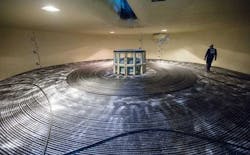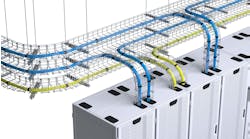The cloud revolution is being felt under the ocean, and is changing how traffic flows across the Internet. The world of subsea communications cables, which for many years was the domain of large global telecom providers, is now being driven by the needs of the largest Internet companies.
The “big four” hyperscale players – Google, Facebook, Microsoft and Amazon – have become the largest investors in new subsea cable routes. Seeking to control their data and networks, these companies are rerouting undersea lanes to bring data traffic ashore near their giant data center campuses. This trend is creating new locations for cable landing stations, which have historically been key points in how data center geography and Internet traffic flows.
Meanwhile, new providers are emerging to build and operate these cables, bringing new methods of managing spectrum that provide more options and flexibility for customers.
“There’s a global subsea resurgence,” says Vinay Nagpal, the President of Interglobix, a new company focused on the intersection of cables and data centers.
Nagpal says the industry has been energized by new players, new economics and new investment. At the center of all these trends are the OTTs – companies using the Internet to go “over the top” of TV and cable companies to deliver streaming content to audiences.
“The industry is driving toward a more diverse set of cable landing sites,” said Nagpal, who for many years led the network team at DuPont Fabros Technology. “I think OTTs are definitely influencers. In the case of Google, when they’re the sole customer, they’re the decision maker.”
New Investments
Google has invested in 14 new subsea cable systems since 2010, including two dedicated systems in which it is the sole investor and customer – Curie, a private cable project to connect the West Coast and its South American data center campus in Chile, and the Dunant cable connecting France and Virginia Beach. Facebook has been a part owner of major capacity buyer on 10 new cable projects, while Microsoft and Amazon are part-owners of two cable systems.
Investment in new subsea cables jumped as hyperscale OTT companies begin to invest strategically in new cable routes. (Chart: Telegeography)
“Private Internets are being built and driving down into the economics,” said Michael Sauer, Vice President, Americas at Aqua Comms. “These companies are deciding where the infrastructure will go. The OTTs are the driver. I think you’re going to see cables built where power is cheap.”
An example: The HAVFRUE trans-Atlantic cable is backed by Google and Facebook and will carry data from Wall, New Jersey to Esbjerg, Denmark, where both companies operate data center campuses. Meanwhile, four different cable systems are set to land in Virginia Beach, bringing data ashore to cloud campuses operated by Microsoft (Boydton, Va.), Facebook (Henrico County, Va.) and Google (Ashburn, Va.)
“It’s all about control and the lowest cost per bit,” said Hunter Newby of Newby Ventures, which invests in cable landing stations. “And the guys driving the bus are the OTTs. That’s why the last 10 or so new cables have been underwritten by OTTs. The carrier might have a role as a partner.
“The content guys need to connect their own data centers, and want it to be private,” said Newby. “They’re concentrating on keeping our data safe from the intelligence agencies.”
New Players
There are 448 submarine cables around the globe, carrying information across 1.2 million kilometers. these cables support $10 trillion in international transactions every day.
Because of the huge cost of these projects, subsea cables were traditionally built by consortiums of telecom companies and end users. Google became the first hyperscale content company to partner in a project in 2010, and began funding dedicated subsea cable routes in 2017.
“When we build privately, we can choose this route based on what will provide the lowest latency for the largest segment of customers,” said Jayne Stowell, Strategic Negotiator of Global Infrastructure for Google. “In this case, we wanted connectivity across the Atlantic that was close to certain data centers.”
The OTTs are not the only new faces. They’ve been joined by a group of new operators that are building cables and offering connectivity services. This group includes companies like Aqua Comms, Seaborn Networks, Crosslake Fibre, DeepBlue Cable, SAEx Global and IOX.
An overview of new players and their projects. (Graphic: InterGlobix)
“I call them the ‘new age’ subsea companies,” said Nagpal. “They have investors behind them. These are guys from the subsea industry who have built cables before. They are seasoned people with sold financial backing from large investors.”
New Technology
There are also new products, including improved capability for multi-tenant capacity on subsea routes. “There’s an emphasis on managed spectrum,” said Nagpal. “The subsea industry is also adopting automated provisioning.”
Newer cable products also can pack more data capacity into cables and conduit, a trend that has implications for the global cable map. The trans-Atlantic MAREA cable, which is backed by Facebook and Microsoft and lands in Virginia Beach, can transmit up to 160 terabits of data per second across the ocean, making it capable of streaming 71 million high-definition videos simultaneously
HAVFRUE is also designed to deliver superior speed and lower latency design. Gil Santaliz, the founder and CEO of the NJFX data center in Wall, N.J., says that as existing transatlantic systems start reaching their 20-year life cycle, the HAVFRUE design will gain an economic advantage over its older rivals.
Analysts agree that the age of established trans-Atlantic cables suggests more shifting tides within the subsea market.
“While there’s certainly lots of investment in new systems, cables built in the late 1990s and early 2000s continue to play a key role in global connectivity,” said Alan Mauldin, a Research Director at TeleGeography. “It seems more likely than ever that some of these cables will begin to go ‘extinct’ in the near future as they are retired from service.”
New Landing Points
All this cloud investment investment has the potential to reshape how data flows across the ocean, onto the U.S. mainland, and into the cloud.
A group of data center companies are seeking to capitalize on this trend, investing in new data centers at the areas where the cables rise from the sea. Historically, cable landing sites have featured minimal infrastructure, perhaps a manhole near the beach where they come ashore and sometimes a small facility operated by the phone company or cable owner. From there, fiber routes carry the data to carrier hotels in major cities like New York or Los Angeles.
Newby has a unique understanding of how subsea cables influence the growth of business ecosystems. As a founder of Telx, an early player in network interconnection, Newby worked to convince submarine cable operators to extend their networks to 60 Hudson Street, the carrier hotel in Manhattan where Telx was based.
For Newby, who left Telx in 2008, the emergence of new cable routes is creating the opportunity to build new intersections – including ones that route around those he previously helped build. He is an investor in 1025 Connect on Long Island as well as the NJFX project. Crosslake Fibre is building a subsea cable between the two data centers, creating a path for data traffic from Europe to bypass Manhattan.
“This is no longer me out in space, thinking crazy thoughts. It has become a real thing – the Continental Edge.”
Hunter Newby of Newby Ventures
“1025 Connect and NJFX are flanking Manhattan and 60 Hudson Street,” said Newby, who said economic models for New York operators have created a “toll gate.” He believes new cables from Latin America that land at NJFX and Virginia Beach can follow a similar strategy, bypassing expensive paths through Miami.
“This is no longer me out in space, thinking crazy thoughts,” said Newby. “It has become a real thing – the Continental Edge.”
Newby and Santaliz are building an ecosystem to carry out this mission, including interconnection specialist DE-CIX, software-defined networking specialist Epsilon and Aqua Comms, whose North Atlantic Loop connects London and Dublin with NJFX and 1025 Connect.
“I think we’re rocking the boat,” said Sauer of Aqua Comms. “We don’t want to be in New York, where it costs more to get from the fourth floor to the fifth floor than it costs to cross the ocean.”
New Strategies
The economics offered by these routes are attractive to the OTT players, whose influence is seen up and down the East Coast cable landing landscape. That includes Virginia Beach, where the newest project illustrates how subsea cables – and their importance to hyperscalers – can influence data center development and strategy.
The new player in Virginia Beach is PointOne, a Canadian developer that is planning a hyperscale data center campus in Fauquier County in central Virginia. In October, PointOne announced plans to invest $80 million to build a cable landing station and interconnection facility in Virginia Beach.
An illustration of the planned PointOne data center in Virginia Beach. (Image:PointOne)
PointOne sees access to the subsea cables as part of its hyperscale-focused strategy. “PointOne’s facility in Corporate Landing Business Park will enable us to offer our clients direct submarine-to-terrestrial fiber connectivity to our hyperscale data center campus located in Remington, Va.,” said Keith Frieser, chairman and CEO of PointOne Development Corporation.
PointOne is using a modular design to deploy its facilities cheaply and quickly. It’s a trend being seen at cable landing stations around the world, which now have access to pre-fab facilities from providers like Xsite Modular, which specializes in modern methods of construction that can make deployments cheaper and faster. Xsite’s designs have recently been used to deploy landing stations in Hawaii, the Phillippines and the Solomon Islands.
“Our cable landing stations can withstand the worst natural disasters, security threats and failure scenarios imaginable,” said Amy Marks, CEO of XSite Modular. “The permanent steel and concrete buildings are designed to a 50-year lifespan and constructed using modular technology, which is ideal for environments such as these.”
The Road Ahead
Modular design and construction, both for landing stations and data centers, is a key part of the broader changes sweeping the Internet infrastructure space.
“Today a data center is a big building with very high redundancy,” said Ivo Ivanov, CEO of DE-CIX. “In the future we may see a new type of data center that’s more flexible to support 5G. This is part of the journey we have in mind. The closer-to-the-edge strategy is driven by the needs of the market, and has to be more distributed. It will change the way we define data centers. ”
In a similar fashion, the subsea cable business is moving ahead quickly. Nagpal believes the innovation and growth will continue.
“For me, it’s early days,” said Nagpal. “The global trend is to focus on connecting the dots. These cables are landing and distributing traffic, and there’s an opportunity to build an ecosystem. In Virginia Beach, for example, there’s an opportunity to build an interconnection platform. That needs to happen somewhere where the subsea network handoff is taking place.
“How big an opportunity? Time will tell.”






